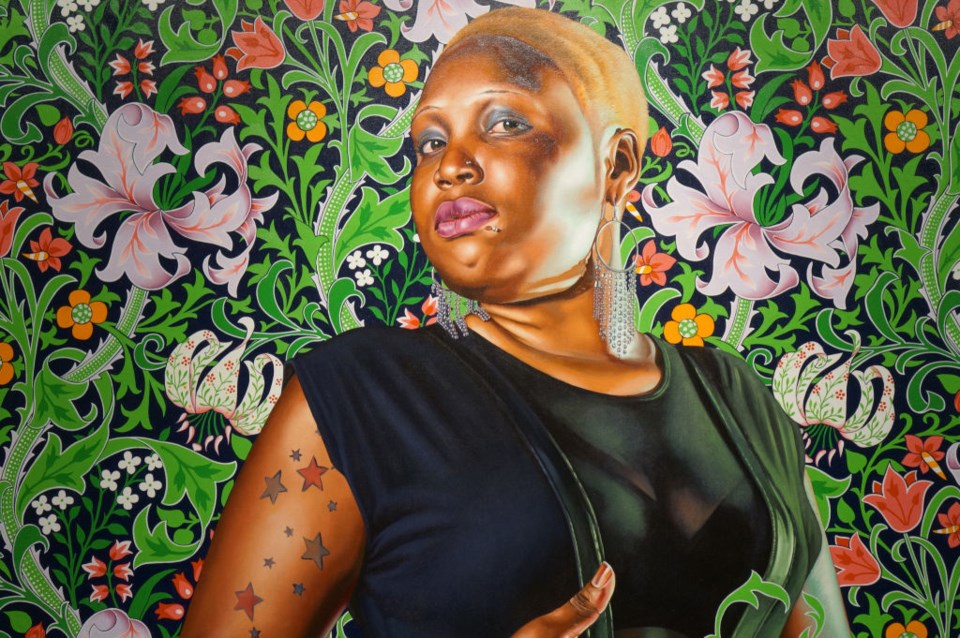
Photo: The Brooklyn Reader
The exhibit, Kehinde Wiley: A New Republic opened Friday at the Brooklyn Museum, celebrating artist Kehinde Wiley's prolific, 14-year career.
"Painting is about the world we live in," says Wiley. "Black people live in the world. My choice is to include them. This is my way of saying yes to us."
Located in the Iris and B. Gerald Cantor Gallery, 5th Floor, Wiley's exhibit raises questions about race, gender and the politics of representation, whereby Wiley paints images of contemporary African-American men over decorative-- rather discordant-- backgrounds, set during a time in history where black and brown faces in such paintings did not exist.
He calls the process "street-casting." Wiley asks everyday people from "the street" to sit while he paints them modeled after another painting or sculpture. The sitters agree while their names remain anonymous.
Suddenly, you see the kid whose mug shot you glanced at-- but barely noticed-- on the evening news the night before, painted by Wiley, supine in a field of daisies. Or you see the guy in line in front of you at the supermarket earlier that week painted head-held-high in a hoodie and on horseback.
His paintings often mimic an artistic tradition reserved for 17th -Century European portraiture— typically aristocrats or religious people shown in their best advantage, with beautiful clothing and accessories that reinforce their status. But in Wiley's, the subjects don tattoos instead of a fur coat or Gucci sneakers instead of riding boots.

Photo: The Brooklyn Reader
What results is cognitive dissonance. So, instead of casually dismissing the person's presence as a natural part of a familiar scenario, you unconsciously separate subject from scenario and within that space, begin really listening to what the subject has to say.
Wiley's thumbprint is distinct and recognizable in his use of color, casting and theme. To say his work carries a signature thread certainly is fair. But to believe his work as undifferentiated reenactments could not be further from the truth.
A New Republic showcases the diversity that exists within Wiley's body of work through two short videos and sixty paintings, including one of Michael Jackson on horseback, and several new paintings featuring everyday women from his series Economy of Grace. In Economy of Grace, he has collaborated with designer Givenchy to custom-create haute couture gowns for his women subjects, who he paints against colorful, ornate backgrounds.
Other works on view include selections from his series World Stage, which started in 2006 in China and is ongoing. World Stage examines the socioeconomic conditions and culture of everyday people in India, Israel, Jamaica, Haiti, Nigeria, Brazil and other countries around the globe.

Photo: The Brooklyn Reader
Also two bronze sculptures, including a breathtaking bronze bust entitled Bound, and a stained glass installation by Wiley, make their debut at the Brooklyn Museum.
Additionally, you may notice, although Wiley's subjects carry his artistic trademark style of painting, the backgrounds vary in style and detail, giving the impression they were painted by someone totally different. That's because in many cases they were:
"There is a long-standing tradition in European paintings, beginning in the Renaissance of ateliers, where there is a master doing the primary painting and workshop assistants that do the background," said Eugenie Tsai, who curated the exhibit, along with Barbara Vogelstein. "His work is very wide and very practiced. So he has a global franchise of painting assistants around the world."
"Similar to Andy Warhol who made paintings of silk screens, he consciously cultivated this idea that art-making is not just about an outpouring of individual emotions but about creating a product."
The paintings that are sure to capture a lot of attention-- mostly because of recognition, association and size-- are the two displayed from Wiley's Down series, very large, billboard-sized paintings of reclining, somber-looking boys, ages 17 — early 20s, against decorative backgrounds.

Photo: The Brooklyn Reader
The name "Down" becomes a play on words, as it can mean several things: the orientation of the person lying down; the emotion of being down-and-out; or the sexual reference of a person who is on the "down low," Tsai pointed out.
From street-casting to re-casting to the renaming of male figures (i.e. Eric Murphy becomes Saint Gregory Palamas), to Wiley's religious referencing across gigantic stained glass, the exhibit "A New Republic" is an emotional, self-reflecting, breathtaking, colorful and somewhat dizzying roller coaster ride. In one word: thrilling.
Kehinde Wiley: A New Republic is on view at the Brooklyn Museum, February 20 - May 24, 2015.




